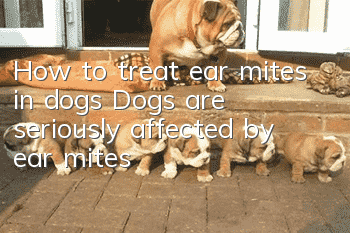How to treat ear mites in dogs? Dogs are seriously affected by ear mites

What are ear mites
Canine ear mites are tiny parasites that live on the surface of the skin and the external auditory canal. They suck lymph fluid and skin cells and feed on tissue residues and tissue nourishment. Ear mites spend their entire lives on their host, laying their eggs in the ear canal and nearby fur. If left untreated, ear mites can cause ear inflammation and potential deafness in dogs. Ear mites are easily spread between animals. Even dogs who are housebound may also be infected, because humans are often temporary carriers.
Symptoms of ear mite infection in dogs
Clinical symptoms of ear mite infection: Pets often scratch their ears and shake their heads. The ears collect a waxy substance (like ground coffee beans) secreted by the sebaceous glands in the external auditory canal. Irritation caused by ear mite saliva makes the external auditory canal red, swollen and inflamed. Frequent scratching and constant shaking of the head can lead to ear hematoma and facial deformation.
Treatment of ear mites
Use polyester earwax to clean the ear canal thoroughly, then drop the therapeutic ear fluid and rub it outside the ear several times to evenly distribute the medicine In the ears, 2-3 times daily. Ear mites are a stubborn disease and require continuous medication for more than 20 days until they are cured. All infected pets in the same household must be treated at the same time to reduce the chance of infecting each other. When cleaning the ear canal, be sure to use hemostats and cotton swabs as cotton swabs; never use cotton swabs, because cotton swabs are too hard and will damage the epithelial cells of the ear canal and may cause future bacterial infection, which may lead to otitis. Or it may pierce the eardrum, causing injury to the inner ear. In addition, cotton swabs will push earwax into the ear canal, blocking the ear canal and affecting treatment.
How to make cotton swabs
Prepare a small hemostatic forceps, then select the amount of cotton swab according to the size of the ear canal, use the hemostatic forceps to roll into a cotton swab to clean the ear, the key points of rolling The method is to lay the cotton wool flat, use the end of the hemostat to clamp a "small part" of the cotton wool, and then rotate it to turn the cotton into a strip. The rolled shape is a long strip, and the thickness should be moderate. At the same time, the front end of the strip should be longer, so that it can go deeper into the ear canal to clean the earwax. At the same time, because the front end is soft, it will not hurt the ear canal. It is recommended to learn this method from professionals.
Key points of ear cleaning
First pour the ear cleaning water into the ear canal, then lift the ear with one hand to prevent the ear cleaning water from flowing out, and massage the ear canal with the other hand to allow the ear cleaning water to flow out. After the water and earwax have fully worked, use a rolled cotton swab to clean the ears. This can be repeated several times. Then instill therapeutic ear drops and massage the ears. The instillation method and gestures are the same as those for ear cleaning.
- Is it better for Dogo dogs to have their ears erect or cropped? A case of Dogo dog’s ear erection surgery will tell you
- What do dogs eat to protect their stomach? It is important to protect their stomach and treat gastrointestinal diseases in dogs.
- How to tell if your dog is fat? Is your dog overweight?
- How to train Tibetan Mastiff Four aspects teach you how to train Tibetan Mastiff
- Will your dog catch a cold if you blow the air conditioner? What should you do if your dog catches a cold if you blow the air conditioner?
- What should you pay attention to when your dog drinks water? Don’t be careless when it comes to your dog’s drinking water.
- The dog's mouth bites and shakes. Why does the dog's mouth occasionally shake and bite?
- How to cut a dog's hair? Do you know how to cut a dog's hair correctly?
- Can dogs eat raw eggs? Why can’t dogs eat egg whites?
- Common Dog Problems in Summer How to Deal with Different Dog Problems



